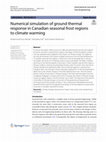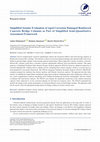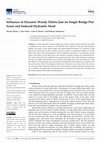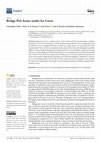Papers by Husham Almansour

Canadian Journal of Civil Engineering, Apr 1, 2010
The construction of new bridges and the renewal of aging highway bridge network using ultra high ... more The construction of new bridges and the renewal of aging highway bridge network using ultra high performance concrete can lead to the construction of long life bridges that will require minimum maintenance resulting in low life cycle costs. Ultra high performance concrete (UHPC) is a newly developed concrete material that provides very high strength and very low permeability. UHPC could enable major improvements over conventional high performance concrete (HPC) bridges in terms of structural efficiency, durability and cost-effectiveness over the long term. A simplified design approach of concrete slab on UHPC girders bridge using the Canadian Highway Bridge Design Code and the current recommendations for UHPC design is proposed. An illustrative example demonstrates that the use of UHPC in precast/prestressed concrete girders yields a more efficient design of the superstructure where considerable reduction in the number of girders and girder size when compared to conventional HPC girders bridge with the same span length. Hence, UHPC results in a significant reduction in concrete volume and then weight of the superstructure, which in turn leads to significant reduction in the dead load on the substructure, especially for the case of aging bridges, thus improving their performance.

Many bridges built in the 1960's and 1970's are considered deficient by today's stand... more Many bridges built in the 1960's and 1970's are considered deficient by today's standards. The widespread deterioration and some recent failures have highlighted the importance of developing and implementing effective inspection strategies, including structural health monitoring systems, which can identify structural problems before they become critical and endanger public safety. Continuous monitoring is becoming necessary due to ageing of bridges, increased traffic loads, changing environmental conditions, and reduced capacities, especially for medium and long-span bridges given the severe consequences of failure. The implementation of monitoring programs can assist in optimizing the in-depth inspection, maintenance, rehabilitation, and replacement of bridge structures. The continuous and simultaneous measurements at critical discrete points of a bridge system will allow the assessment of its performance with respect to different limit states, including safety and serviceability. Prediction models, updated from such monitoring data, can optimize intervention strategies as to how and when to repair or rehabilitate thus extending service life and reducing life-cycle costs. The objectives of this paper are: (i) to present an approach for the efficient use of structural health monitoring into the durability and structural reliability assessment process; (ii) to highlight the applicability of the approach to short, medium and long-span bridges; and (iii) to demonstrate the effective use of field monitoring data for the calibration and updating of service life prediction models. A case study on a medium-span concrete highway bridge is also presented and used to illustrate the approach. (A)

Journal of Physics: Conference Series, 2021
Recent advances in analysis, and design approaches led to a considerable reduction of the structu... more Recent advances in analysis, and design approaches led to a considerable reduction of the structural elements’ size and weight. Heavy multi-axle trucks are now standardized in North America, and elsewhere, the traffic speed and the average number of trucks passing bridges have dramatically increased. For the purpose of the design and/or assessment of bridge structures, it is imperative to evaluate the static deformations, frequency, vibration amplitudes, and dynamic deformation patterns of new and aged bridges due to the new five-axle versus the old two-axle design trucks. This study investigated the effects of using a recent standard multi-axle design truck on the dynamic performance of a frame bridge. It presents a comparison of the bridge dynamic performance under 2-axle and 5-axle moving trucks. A two-dimensional nonlinear finite element model is used to model the frame, and trucks are modelled as a multi-degree of freedom dynamic system integrated with the bridge model. It is f...
All-advanced composite bridge superstructure represents a significant advance in the use of advan... more All-advanced composite bridge superstructure represents a significant advance in the use of advanced composites in civil-structures. However, one of the critical obstacles to extensive use of advanced composites in construction is the lack of simplified and practical design guidelines. In this paper, an iterative performance based multi-scale analysis and design approach for all-advanced composite bridge superstructure is proposed. The bridge superstructure is formed from laminated FRP box girder and chopped FRP top surface plate. Several laminate designs are examined and the performance of the most efficient material and structural design of the proposed bridge is compared to a slab on prestressed concrete bridge. The results show that the proposed procedure leads to an efficient use of the materials with highest structural performance.

International Journal of Geo-Engineering
To ensure that public infrastructure can safely provide essential services and support economic a... more To ensure that public infrastructure can safely provide essential services and support economic activities in seasonal frost regions, the design of their foundation systems must be updated and/or adapted to the impacts of climate change. This objective can only be achieved, if the impact of global warming on the soil thermal behaviour in Canadian seasonal frost regions is well-known and can be predicted. In the present paper, the results of a modeling study to assess and predict the effect of global warming on the thermal regimes of grounds in three Canadian seasonal frost regions (Ottawa, Sudbury, Toronto) are presented and discussed. The results show that future climate changes will significantly affect the soil thermal regimes in seasonal frost Canadian areas. The simulation results indicated a gradual loss in the frost penetration depth due to the climate change, in the three representative sites. The frost period duration will be shorter due to climate change in the three selec...
Proceedings of the 8th International Conference on Civil, Structural and Transportation Engineering (ICCSTE 2023)
Proceedings of the 8th International Conference on Civil, Structural and Transportation Engineering (ICCSTE 2023)
Proceedings of the 8th International Conference on Civil, Structural and Transportation Engineering (ICCSTE 2023)

Engineering Science & Technology
Severe reinforcement corrosion significantly reduces the structural stiffness and load-carrying c... more Severe reinforcement corrosion significantly reduces the structural stiffness and load-carrying capacity of Reinforced Concrete (RC) columns. The interactive effects of corrosion-induced damage and repeated traffic load cycles further accelerate bridge columns' load-carrying capacity deterioration. When subjected to seismic excitation, corrosion-affected RC columns could show a dynamic response significantly different from non-affected columns. This paper proposes a Simplified Nonlinear finite element Seismic Analysis approach (SNLSA) based on enhanced inspection of corrosion-damaged RC columns and as a handy tool for evaluating their seismic response, which is a crucial step in a semi-quantitative assessment framework. The SNLSA integrates Nonlinear Sectional Analysis (NLSA), DRAIN-RC computer program for nonlinear time history analysis, and Takeda's hysteretic analysis. The approach provides three options: (i) establish the staged failure mechanism using express analysis s...
Proceedings of the 39th IAHR World Congress, 2022

Journal of Marine Science and Engineering
A woody debris jam around a bridge pier causes a change in flow structure and results in addition... more A woody debris jam around a bridge pier causes a change in flow structure and results in additional scour and an increase in the hydraulic head upstream of the pier, threatening its stability and safety. In the present paper, the spatio-temporal formation of a dynamic woody debris jam formed piece by piece of debris wood was used to investigate the influence of woody debris jams from a life-cycle perspective which included the processes of its formation, growth, failure, and rebirth. Several debris jams were formed in sequence during each experimental test. The results showed that the additional scour generated by the first woody debris jam compared with the scour depth without debris was a function of blockage ratio of the first debris jam, while the influence of the subsequent woody debris jams depended on their dimensions compared with the previous jam. When the subsequent debris jam’s dimensions were larger than the previous one, the scour further increased; otherwise, the scour...
Journal of Hydraulic Research

Water
Bridge pier scour is a complex process, which is influenced by many parameters, including the pre... more Bridge pier scour is a complex process, which is influenced by many parameters, including the presence of ice cover around piers. To better understand the influence of ice on bridge pier scour, an artificial ice cover, equipped with either a smooth or a rough surface, was constructed and tested experimentally. The ice cover was positioned on the surface of the water and submerged to specified depths in order to replicate floating and fixed (pressurized) ice cover conditions, respectively. During each test, a velocity profile was collected beneath the ice cover, and after each test, a three-dimensional scan of the bed was collected to compare the resulting scour. It was discovered that the presence of an ice cover around a bridge pier increased pier scour under all conditions. Furthermore, as the ice cover was submerged deeper into the flow, the flow velocity increased, and greater scour resulted. For each level of submergence, the rough ice cover yielded increased scour depths compa...

Les bâtiments, les ponts, les routes, le transport en commun sur rail de même que les réseaux d&#... more Les bâtiments, les ponts, les routes, le transport en commun sur rail de même que les réseaux d'alimentation en eau potable et d'évacuation des eaux usées du Canada fournissent un abri et de l'eau potable, et permettent le transport des personnes et des marchandises ainsi que la collecte et le traitement des eaux usées. Ils fournissent des services de base essentiels aux Canadiens et sont d'une importance cruciale pour l'économie canadienne et la qualité de vie de la nation. Ces bâtiments et infrastructures publiques de base (BIPB) subissent des effets incertains et variables dans le temps en raison des changements climatiques, et sont soumis à des événements météorologiques extrêmes plus fréquents, comme les inondations. Ces pressions induites par les changements climatiques pourraient éventuellement réduire la sécurité, le rendement en service, la fonctionnalité et la durée de vie des BIPB du Canada. De plus, les BIPB canadiens vieillissent et se détériorent en...
... composites. Husham H Almansour Dissertation Abstracts International 68:0404, 2006. ... types.... more ... composites. Husham H Almansour Dissertation Abstracts International 68:0404, 2006. ... types. On the other hand, the" Laminas Dominant Fiber Alignment" principle, LDFA, is introduced together with a simplified rule of laminate lay-up. ...










Uploads
Papers by Husham Almansour